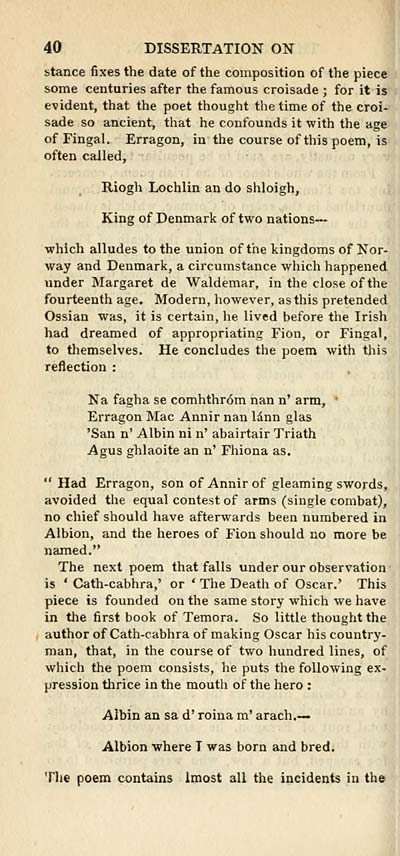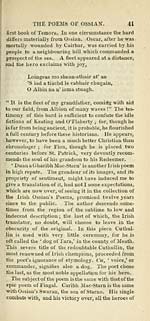Ossian Collection > Poems of Ossian
(88)
Download files
Complete book:
Individual page:
Thumbnail gallery: Grid view | List view

40 DISSERTATION ON
stance fixes the date of the composition of the piece
some centuries after the famous croisade ; for it is
evident, that the poet thought the time of the croi-
sade so ancient, that he confounds it with the age
of Fingal. Erragon, in the course of this poem, is
often called,
Riogh Lochlin an do shloigh,
King of Denmark of two nations--
which alludes to the union of the kingdoms of Nor-
way and Denmark, a circumstance which happened
under Margaret de Waldemar, in the close of the
fourteenth age. Modern, liowever, as this pretended
Ossian was, it is certain, he lived before the Irish
had dreamed of appropriating Fion, or Fingal,
to themselves. He concludes the poem with this
reflection :
Na fagha se comhthrom nan n' arm, ■
Erragon Mac Annir nan Idnn glas
'San n' Albin ni n' abairtair Triath
Agus ghlaoite an n' Fhiona as.
" Had Erragon, son of Annir of gleaming swords,
avoided the equal contest of arms (single combat),
no chief should have afterwards been numbered in
Albion, and the heroes of Fion should no more be
named."
The next poem that falls under our observation
is ' Cath-cabhra,' or * The Death of Oscar.' This
piece is founded on the same story which we have
in the first book of Temora. So little thought the
author of Cath-cabhra of making Oscar his country-
man, that, in the course of two hundred lines, of
which the poem consists, he puts the following ex-
pression thrice in the mouth of the hero :
Albin an sa d' roina m' arach.—
Albion where T was born and bred.
The poem contains Imost all the incidents in the
stance fixes the date of the composition of the piece
some centuries after the famous croisade ; for it is
evident, that the poet thought the time of the croi-
sade so ancient, that he confounds it with the age
of Fingal. Erragon, in the course of this poem, is
often called,
Riogh Lochlin an do shloigh,
King of Denmark of two nations--
which alludes to the union of the kingdoms of Nor-
way and Denmark, a circumstance which happened
under Margaret de Waldemar, in the close of the
fourteenth age. Modern, liowever, as this pretended
Ossian was, it is certain, he lived before the Irish
had dreamed of appropriating Fion, or Fingal,
to themselves. He concludes the poem with this
reflection :
Na fagha se comhthrom nan n' arm, ■
Erragon Mac Annir nan Idnn glas
'San n' Albin ni n' abairtair Triath
Agus ghlaoite an n' Fhiona as.
" Had Erragon, son of Annir of gleaming swords,
avoided the equal contest of arms (single combat),
no chief should have afterwards been numbered in
Albion, and the heroes of Fion should no more be
named."
The next poem that falls under our observation
is ' Cath-cabhra,' or * The Death of Oscar.' This
piece is founded on the same story which we have
in the first book of Temora. So little thought the
author of Cath-cabhra of making Oscar his country-
man, that, in the course of two hundred lines, of
which the poem consists, he puts the following ex-
pression thrice in the mouth of the hero :
Albin an sa d' roina m' arach.—
Albion where T was born and bred.
The poem contains Imost all the incidents in the
Set display mode to: Large image | Transcription
Images and transcriptions on this page, including medium image downloads, may be used under the Creative Commons Attribution 4.0 International Licence unless otherwise stated. ![]()
| Early Gaelic Book Collections > Ossian Collection > Poems of Ossian > (88) |
|---|
| Permanent URL | https://digital.nls.uk/77989921 |
|---|
| Description | Selected books from the Ossian Collection of 327 volumes, originally assembled by J. Norman Methven of Perth. Different editions and translations of James MacPherson's epic poem 'Ossian', some with a map of the 'Kingdom of Connor'. Also secondary material relating to Ossianic poetry and the Ossian controversy. |
|---|
| Description | Selected items from five 'Special and Named Printed Collections'. Includes books in Gaelic and other Celtic languages, works about the Gaels, their languages, literature, culture and history. |
|---|

